Arkansas Catocala
Catocala vidua, Ozark Mountains, Searcy County, Arkansas,
October 4, 2011, courtesy of Marvin Smith.
|
|
Updated as per "Systematics of moths in the genus Catocala (Lepidoptera, Erebidae) IV. Nomenclatorial stabilization of the Nearctic fauna, with a revised synonymic check list"; ZooKeys 39: 37–83 (2010) by Lawrence F. Gall, David C. Hawks; March 21, 2010 Updated as per personal communication with Marvin Smith, October 2011; March 2012 |
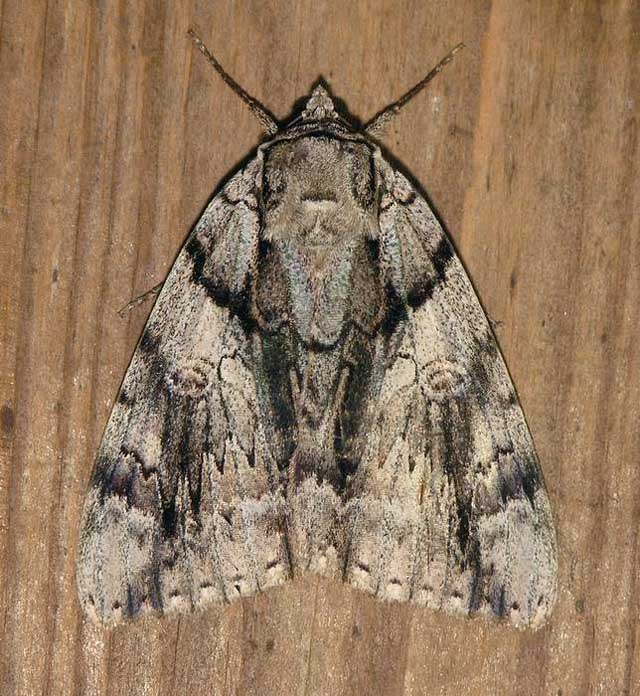
As of April 4, 2010, this page has been further updated as per research data compiled by Larry Gall.
I would like to continue to refine the listings to county levels so images and data (date, location at least to county level,
bait, lights) would be very much appreciated. Please send same to Bill Oehlke.
All images that I use on my websites remain the property of respective photographers and images are credited as such.
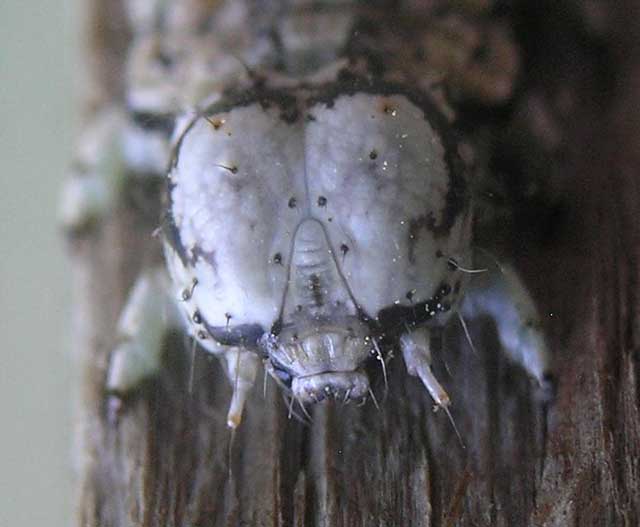
Catocala ilia larval head, Searcy County, Arkansas,
March 31, 2012, courtesy of Marvin Smith.
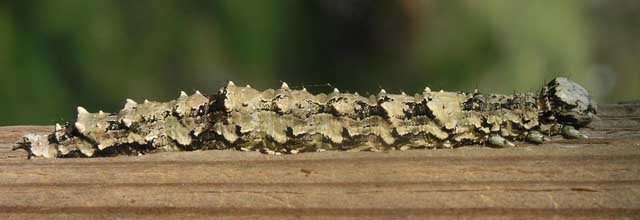
Catocala ilia fifth instar, Searcy County, Arkansas,
March 31, 2012, courtesy of Marvin Smith.

Catocala ilia fifth instar, Searcy County, Arkansas,
March 31, 2012, courtesy of Marvin Smith.
Visit Arkansas Sphingidae: Hawk Moths/Sphinx Moths
Little Yellow-Orange Underwings: Wingspans: 30-45mm
Little Yellow-Orange Underwings: Wingspans: 35-56mm |
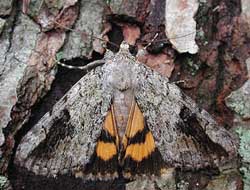
| ** 8876 Catocala micronympha, the Little Nymph Underwing, (wingspan: 35-50mm); John Himmelman image. Usual specimens have grey forewings shaded with green, brown, black and white tints. Usually a darkened band passing from costa through reniform spot to outer margin. High variability. Full size Joe Garris photo of C. micronympha form hero. |
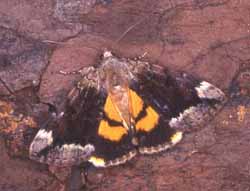
| ** 8876 Catocala micronympha
form gisela,
the Little Nymph Underwing, (wingspan: 35-50mm). |
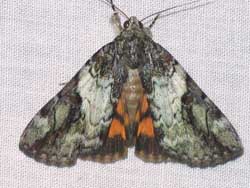
| ** 8876 Catocala micronympha
form hero,
the Little Nymph Underwing, (wingspan: 35-50mm).
The usual specimens have grey forewings shaded with green, brown,
black and white tints. There is usually a darkened band passing from
the costa through the reniform spot to the outer margin.
Form "hero" H. Edwards has a median area that is mostly white. |
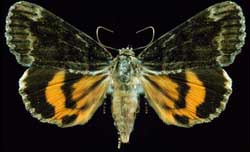
| ** 8876 Catocala micronympha form lolita, the Little Nymph Underwing, (wingspan: 35-50mm).Form "lolita" Sargent has very dark forewings. Harold J. Vermes image, used with permission from his son. |
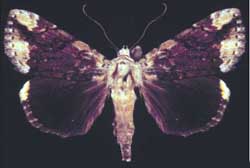
| ** 8876 Catocala micronympha form sargenti, the Little Nymph Underwing, (wingspan: 35-50mm). Usual specimens have grey forewings shaded with green, brown, black and white tints. Usually a darkened band passing from costa through reniform spot to outer margin. Form "sargenti" Covell (very rare) has a hindwing that is all black. |
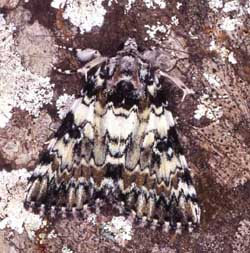
| ** 8877 connubialis, Connubial Underwing, (wingspan: 35-50mm). Fw highly variable; several different forms: "sancta": typical form, fws with white ground colour and sharply contrasting black lines and markings. Brown shading between post medial and subterminal lines; "cordelia": coloured as above, markings faint; "pulverulenta": grey-green fws with faint markings, sometimes none; "broweri": melanic form with fws dark green, almost black. Hw: separate anal spot, outer band ends with a straight cut. Leroy Simon image. |
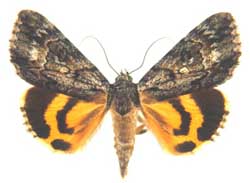
| ** 8848 bastropi, Bastroph Underwing, (wingspan: 40mm). There is a distinct white "smile" (in spread specimens) between the reniform and subreniform spots. There is also a narrow but distinct white line immediately following the black postmedial line. Hw deep yellow orange, outer black band interrupted, followed by dot, ending before im. replaces (2017) louiseae in Arkansas |
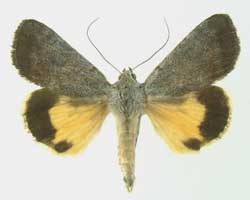
| messalina, Messalina Underwing, (40-45mm); The forewing is a plain, dull, grey-green, darkening toward the outer margin.The hindwing is like that of the false underwing, having no inner black band. The outer band is quite wide. C. messalina flies in evergreen oak habitats. |
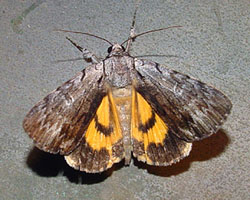
| ** 8772 gracilis; Graceful Underwing, wingspan 40-45mm.Gracilis closely resembles sordida but the hindwing loop is not complete in gracilis as it is in sordida. Gracilis also tends to have a darker inner margin and there is frequently (99% of the time, Dale Schweitzer, via Joe Garris), but not always, a basal dash. Sordida never has the basal dash. |
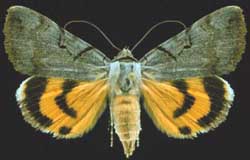
| ** 8841 Catocala abbreviatella; Abbreviated Underwing; 40-50mm. Fw uniformly colored with narrow black lines on anterior half. Brown reniform spot ringed with black. Hw outer black band abbreviated and then continued with dot. Inner black band terminates well before im. Similar species: C. nuptialis solid black reniform spot. C. whitneyi broad dark triangles mid fw. |
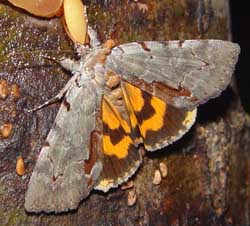
| ** 8864 Catocala grynea ; Woody Underwing; 40-50mm:
The forewing is a dull greenish grey with orangey-brown shading along
the inner margin. The antemedial, median and postmedial lines are
quite faint.
Praeclara is somewhat similar but has a break in the brown shading
between the am and pm lines. Praeclara also has a paler orange
hindwing color. |
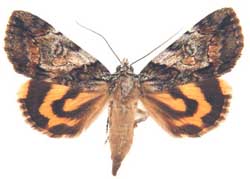
| Catocala pretiosa
Precious Underwing; 40-50mm;
The median area is quite light with a wide whitish band paralleling the antemedial line from the costa almost to the
inner margin. The subreniform spot is distinctly brown. |
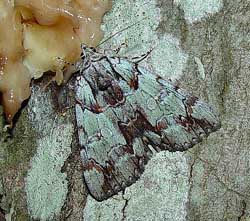
| ** 8865 praeclara; Praeclara Underwing, wingspan: 40-50mm. Fw pale greenish-grey with considerable contrasting brown shading beyond post medial line. There is a black basal dash very close to the inner margin and another dash, higher up in the median area. Note the contrasting shapes of the reniform and subreniform spots. Upper of two larger pml teeth is longer, wider than lower tooth. Note double, white filled amls. Lighter, subcircular patch, outlined in black, brown on lower thorax. |
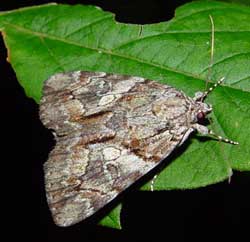
| Catocala mira; Wonderful Underwing, wingspan: 40-50mm. Pale basal area of fw distinguishes mira from blandula (dark brown) and crataegi (black). Fw lacks dark contrasting lines of crataegi and blandula. Considerable brown in subterminal area and subreniform spot very conspicuous, usually brown. Light area runs obliquely from costa to subreniform spot. Noticeable space along i. m. between antemedial and postmedial lines. Hw deep orange and has a complete inner black band. The outer black band is unbroken Tim Dyson image. |
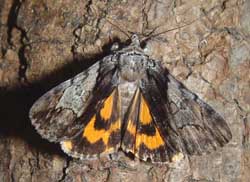
| ** 8858 Catocala crataegi Hawthorn Underwing; 40-50mm; as subspecies 1 Determination is based on dark (black) shading in forewing basal area continuing along inner margin to anal angle and brown shading beyond postmedial line. There is also a definite greenish cast to median area. The lower wing has the outer black band, broken near the anal angle, distinguishing crataegi from blandula. Tim Dyson image. |
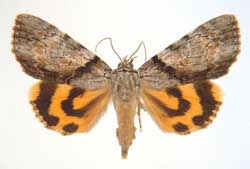
| ** 8860 lincolnana, Underwing, (wingspan: 40-50mm). Fws pale grey-brown with distinct dark curve running from costa along antemedial line to im, advancing to anal angle. Hw inner black band forms complete loop, outer black band broken and followed by dot. |
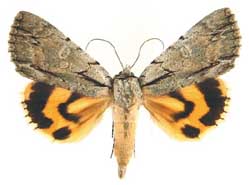
| ** 8772 clintoni; Clinton's Underwing; 45-55mm; The black basal dash distinguishes clintoni from illecta and abbreviatella, both of which lack the dash.Vernon Brou image. |

| ** 8772 gracilis; Graceful Underwing, 40-45mm: Gracilis closely resembles sordida but the hindwing loop is not complete in gracilis as it is in sordida. Gracilis also tends to have a darker inner margin and there is frequently (99% of the time, Dale Schweitzer, via Joe Garris), but not always, a basal dash. Sordida never has the basal dash. |
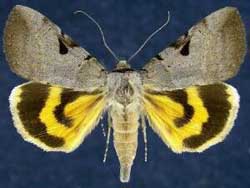
| ** 8858 Catocala nuptialis TM; Married Underwing, wingspan: 40-50mm
The reniform spot is very dark, black or almost black on an otherwise faintly marked, almost uniformly grey forewing.
The outer black margin of the hindwing is unbroken, but is indented near the anal angle. |
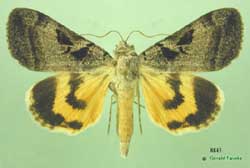
| ** 8843 whitneyi; Whitney's Underwing; 43-50mm. Catocala whitneyi is similar to abbreviatella Grote, and nuptialis Walker, but generally flies later in the season where the species overlap. The two black wedges/triangles on the forewing, one over the reniform spot and the other just outside the antemedial line, distinguish whitneyi. Gerald Fauske image. |
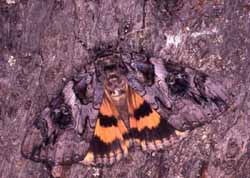 |
** 8844 amestris; Three-staff Underwing; wingspan 43-50mm.There is a large pale patch near the apex. In form "westcotti" the hindwing outer black band is complete. In other moths, the band is broken as in abbreviatella. Hindwing ground colour is usually deeper yellow-orange than in similar species. Leroy Simon image. |
Midsized Orange-Salmon-Red-Scarlet Underwings: Wingspans: 50-72mm
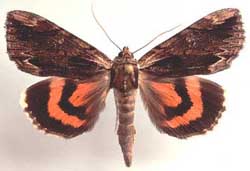
| ** 8857 Catocala ultronia OK/TX; Ultronia Underwing; 50-63mm; GSMNP/TP/WAM; The forewings are typically gray-brown, with a distinct and very dark inner margin and a characteristic light brown patch, underscored by a very dark arc, near the wingtip.There can be considerable variation from one specimen to the next. Underwings can be yellow to orange to salmon. |
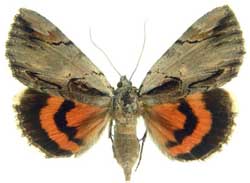
| ** 8857 Catocala ultronia form lucinda; Ultronia Underwing, wingspan: 50-63mm.In form lucinda most of the forewing is bright grey. On all forms there is
extensive orange-salmon colouration on hw ventral surface,
and there is a dark discal lunule. |
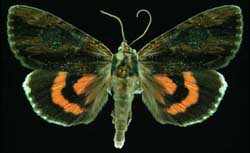
| Catocala ultronia, form nigrescens, the Ultronia Underwing, wingspan: 50-63mm. In the melanic form nigrescens, the dorsal forewing is very dark. Even darker subapical arc, basal dash and dash near anal angle are still visible. Dark basal hairs on hindwing. Harold J. Vermes slide, used with permission from his son. |
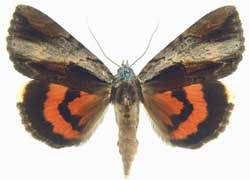
| Catocala ultronia form celia.
In form celia there is a wide, light grey band separating a dark region along inner margin and
a dark patch near the apex.
The ventral surface of forewings of all forms has a generous suffusion
of orange-salmon scales in the lower half of the median area. |
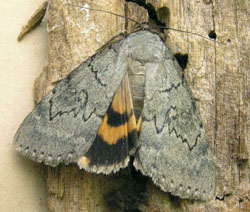 |
** 8779 serena Serene Underwing. Head & collar & abdomen are brown while thorax is grey. Am & pm lines are thin, very dark, distinct on an otherwise drab, almost uniformly olive-grey fw. Black marginal band of lower wings is indented at center, relatively narrow, deep yellow median band parallels indentation. Basal hairs are brown. |
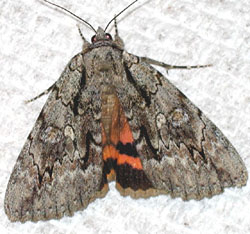
| #8778
Catocala habilis;
wingspan: 55-65mm |
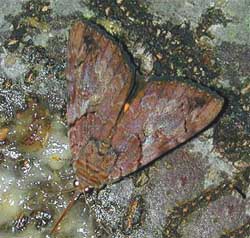
| ** 8774 muliercula; Little Wife Underwing, 54-70mm: The black bands of the hindwings tend to be very wide and there is considerable dark scaling along the inner margins. Hw fringe is very dark as is the general reddish-brown ground colour of the forewings.The forewing apex is preceded along the costa by a lighter, grey-brown patch. Steve Walter image. |
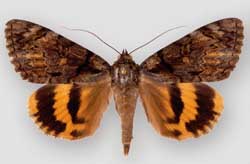
| Catocala delilah; 58-65; The forewing is gray-brown with prominent black antemedial and postmedial lines. The hindwing is yellow-orange, with a narrow inner black band which reaches the inner margin. There is a large yellow spot at the apex, and the fringe is faintly barred. The underside of the wings is deep yellow with black bands. |
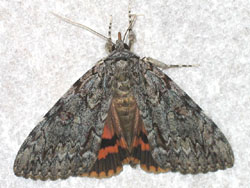
| #8795 Catocala palaeogama ; wingspan: 60-70mm. Subreniform spot closed, does not approach pm line, is smaller than in C. habilis. All forms have characteristic orange, heavily barred fringe to apex, and irregular bands on hws. Hw basal median area heavily suffused with dark brown to black scales. Dark bar in outer half of median area, paralleling i. m. halfway between i. m. and light, closed subreniform spot. Joe Garris photo. |
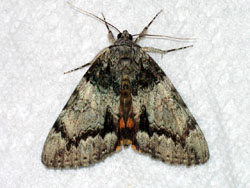
| #8795 Catocala palaeogama form phalanga; wingspan: 60-70mm. In this form, fw basal area and subterminal area are very dark against a much lighter background. Dark bar in the outer half of the median area, paralleling the inner margin halfway between the inner margin and the light, closed subreniform spot is especially evident. Joe Garris image. |
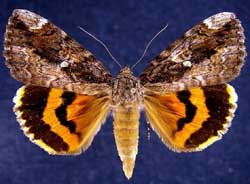
| ** 8770 Catocala innubens; Betrothed; 55-72mm. Forewing is mottled with white, grey and brown, and subrenifrom spot tends to be lighter in colour, although it is sometimes obscured by an indistinct blackish bar which runs from middle of basal/thorax connection to just below much lighter apex at outer margin.Jim Vargo image. |
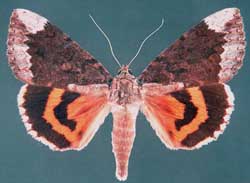
| ** 8770 Catocala innubens form scintillans; Betrothed; 55-72mm.In form scintillans most of the basal area (all but lower third) and all of the median area of the forewing is dark reddish brown. The area outside the pm line is grey. Vernon A Brou image. |
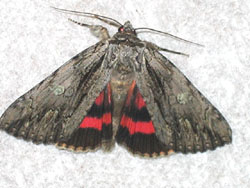
| ** 8851 Catocala coccinata; Scarlet; 57-70mm: Diffuse basal, anal dashes on otherwise light grey, mottled fw. Hw fringe white (often with some salmon scaling), heavily checked. "Tooth" just below pair of very elongated "teeth" is much reduced, quite rounded, usually allowing considerable room for lighter patch of scales. Dark bar crosses thorax. Reniform spot light, often with greenish cast. Joe Garris image. |
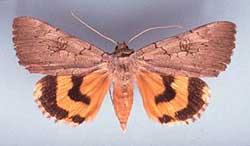
| ** 8840
Catocala illecta OK;
Magdalen Underwing, 60-70mm:
The forewing pattern and colouration is much like that of concumbens,
pale grey with faint black lines. |
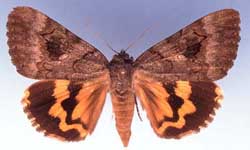
| ** 8772 Catocala consors WO; Consort, wingspan: 70mm plus. Fw with irregular am and pm narrow black lines. Dark patch outside the reniform and subreniform spots. The orange-yellow hindwing pm band tends to be narrow and irregularly zigzagged. Sometimes the band is wider and slightly less irregular. James K. Adams image. |
Solid Black Underwings: Smallest to Largest, Similar Species Paired
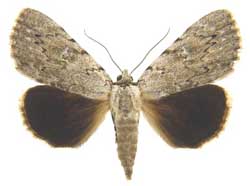
| orba, Orba Underwing; 40-45mm; The forewing is a uniform grey with light lines and poorly defined spots. The hindwing underside is completely black. The hindwing fringe is unbroken and slightly off white, somewhat grey. Note absence of any dark bar in the median-subterminal area, paralleling the inner margin, near anal angle. |
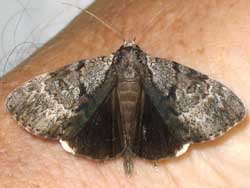
| Catocala andromedae, Gloomy Underwing, (wingspan: 40-50mm). Black underwings and dark grey fringe of hws, coupled with dark inner margin of forewings help to identify this species. There is also a very dark "flying saucer" shape, adjoining subreniform spot to midpoint of am line. The "teeth" of pm line short and blunt, outwardly edged with white. Subterminal line is also outwardly edged with white. |
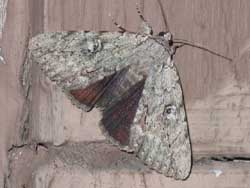
| ** 8781 judith, Judith's Underwing, (wingspan: 45-55mm), yes, small "black" underwing. FW uniform light grey with thin, only slightly darkened am, median and pml lines. No darkened dashes (slight anal dash) or transverse lines. Reniform area slightly darkened while area just before subterminal line is bit lighter. Note absence of hw white fringe. Joe Garris photo. yes |
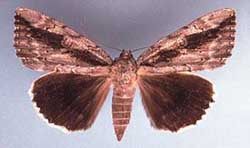
| ** 8782 Catocala flebilis, yes; Mournful, wingspan: 54-65mm. Diffuse black band runs from basal area to outer margin just below apex, interrupted by pale grey subreniform spot. Reniform spot is filled with brown; there is additional brown outside postmedial line. No anal dash as there is in angusi. The hindwings have white fringe. J. K. Adams image. |
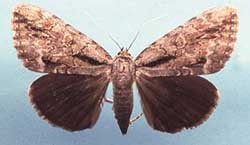
| ** 8783 Catocala angusi WO; Angus' Underwing, 60-74mm; Dark dashes/streaks in basal & anal areas distinguish angusi. Reniform spot: light brown filling. Hw fringe black except for white at apex. Form lucetta has broad black band from basal area to o.m., broken by reniform & subreniform spots. |

| ** 8783 Catocala angusi Angus' Underwing, 60-74mm; Dark dashes/streaks in basal & anal areas distinguish angusi. Reniform spot: light brown filling. Hw fringe black except for white at apex. Form lucetta has broad black band from basal area to o.m., broken by reniform & subreniform spots. unconfirmed |
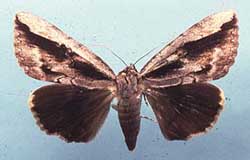
| ** 8783 Catocala angusi Angus' Underwing, 60-74mm; Dark dashes/streaks in basal & anal areas distinguish angusi. Reniform spot: light brown filling. Hw fringe black except for white at apex. Form lucetta: broad black band from basal area to o.m., broken by reniform & subreniform spots. |
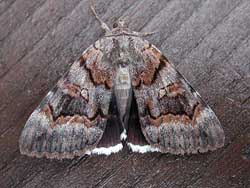
| ** 8773
Catocala epione :
Epione Underwing, wingspan: 55-65mm |
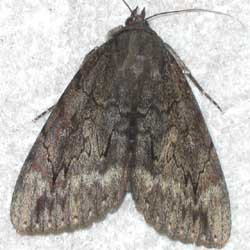
| Catocala residua; Residua Underwing, (wingspan: 60-73mm), distinguished from Catocala obscura by grey hw fringe of residua. Catocala obscura has white to off-white fringe and tends to be less common in northern portions of its range. Fw subterminal line/area of Catocala residua tends to be pale as is its open, elongated subreniform spot. Like C. obscura it is otherwise devoid of significant markings except for hint of dark bar running from basal area through reniform spot to o. m. just below apex. |
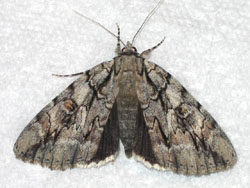
| Catocala retecta; wingspan: 60-75mm. Note light coloured, elongated and open subreniform spot which interrupts dark, diffuse ark running through center of wing from basal area (body-wing juncture) to fw apex. Center of reniform spot brown and there is a brown area just below costa running to inner margin just outside pm line. Off-white hindwing fringe only lightly checked along wing veins. Joe Garris image. |
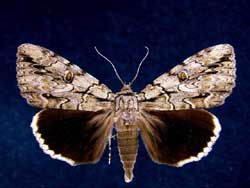
| Catocala luctuosa; 70mm: Light grey (yellowish tint) fw clearly marked with basal dash continuing with another dash through am line, then another anal dash almost forming bar parallel to the im. Hw fringe white & only lightly barred at veins. The "teeth" in the forewing postmedial line are elongated and dark, continuing a dark dar emanating from the outer margin just below the apex. |
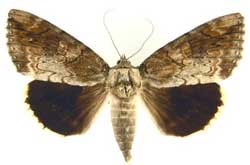
| Catocala atocala: Upper half of thin distinct am line runs obliquely toward anal angle, turns making two lobes to im; basal area darker grey-brown; large light brown reniform and closed subreniform spots; dark upper half median and brown subterminal areas, lighter lower half; thin, distinct pm line with two elongated upper teeth; almost white along entire im. |
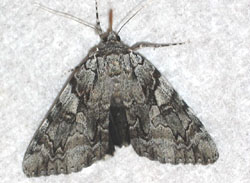
| Catocala dejecta, yes, (wingspan: 56-73mm; Hodge #8790). Dejected Underwing quite similar to Catocala retecta. Light coloured subreniform spot also open, but has distinct "pork-chop" shape and separates much darker median area below subreniform spot from very light area to costa above spot. Lower quarter of submarginal area much darker in C. dejecta than in C. retecta. |
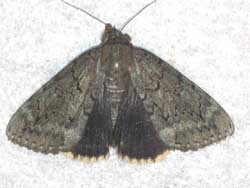
| ** 8784 obscura; the Obscure Underwing, (wingspan: 60-72mm), has dull, grey forewings, usually void of any significant dashes, streaks, providing for easy identification. Am, median and pm lines faint and subterminal line region is only slightly paler than rest of fw. Hw fringe is off-white, lightly checked on veins. Joe Garris photo. |
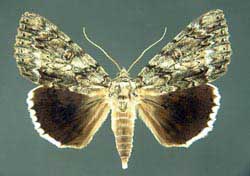
| ulalume; Ulalume Underwing; 62-75mm: The forewing colouration is a mottled light to dark grey with no strongly contrasting lines, dashes or bars. At the inner margin the antemedial line ends with in a very light coloured crescent. The subrenifrom spot is also light coloured and "comma" shaped. The hindwing is black and the fringe is pure white with thin, sharp (pointed) checking. |
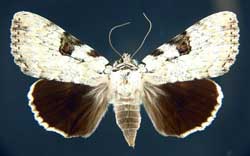
|
Catocala sappho;
Sappho Underwing; 60-75mm: |
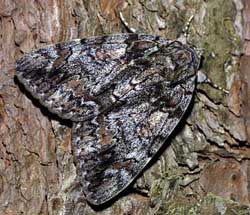
| ** 8794
Catocala lacrymosa;
Tearful Underwing, 60-82mm.
The forewing is highly variable with a mixture of black, brown
(wing tips and outside postmedial line) and dark grey scaling.
There are usually whitish crescents, along the inner margin at the
base of the antemedial and postmedial lines. |
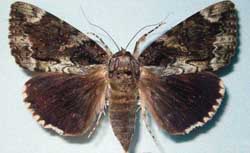
| ** 8794
Catocala lacrymosa;
Tearful Underwing, 60-82mm.
Form paulina: lighter grey post median area & area along and parallel to inner margin, in sharp contrast to
darker basal median areas. |
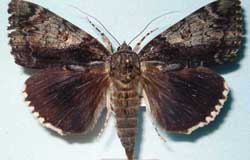
| ** 8794
Catocala lacrymosa;
Tearful Underwing, 60-82mm. |
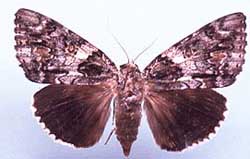
| ** 8794 Catocala lacrymosa; Tearful Underwing, 60-82mm;; GSMNP/TP/WAM/KC. In form albomarginata there is an abundance of white scaling on the forewing. |
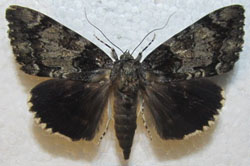
| ** 8794 Catocala lacrymosa; Tearful Underwing, 60-82mm;; TP. Form "zelica", has black basal patch and strong black subterminal line. |

| ** 8783 Catocala angusi
Angus' Underwing, 60-74mm. |

| ** 8783 Catocala angusi Angus' Underwing, 60-74mm; Dark dashes/streaks in basal & anal areas. Reniform spot: light brown filling. Hw fringe black except for white region at apex. Form lucetta has broad black band from basal area to om, broken only by reniform & subreniform spots. James K. Adams image. |
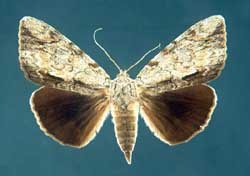
| ** 8791
Catocala insolabilis;
Inconsolable, wingspan: 65-75mm;
Fw light grey with blackish shading along inner
margin. Am and pm lines are thin.
Hw fringe is very narrow and grey, becoming whiter toward
the apex.
The ventral surface clearly distinguishes insolabis, being almost
completely black except for some white in the basal area. |
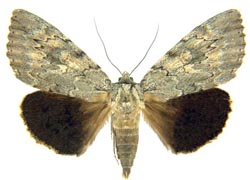
| ** 8780 Catocala robinsoni; 70-80mm. Fws relatively plain pale grey. Female has basal dash, absent in male. Currata French, 1882, female form: weak basal dash. Rare form missouriensis Schwarz, 1915: dark, broad bar extending from basal area to o.m. just below apex. Lighter grey rnfm, subrnfm spots break bar in missouriensis, found from PA. to FL. Hw fringe: White; bands on ventral surface prominent. |
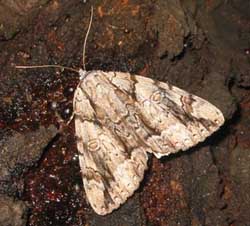
| ** 8792 Catocala vidua; Widow; 70-80mm. Fw ground colour light grey. Distinguishing dark arc runs through top of reniform spot to just below apex. Heavy, dark anal & basal dashes, connecting to dark median bar, running parallel to i. m. Am line thick, black in its upper half. Reniform spot with two almost concentric irregular ovals. Subreniform spot light, open, constricted as it meets pm line. Hw black with broad, white fringe, lightly interrupted. Often with blue-green scales in fw basal area. |

| Catocala atocala, Underwing, (wingspan: approximately 70-75mm). Similar to agrippina, but reniform is more clearly defined in atocala. Closed subreniform of atocala may be open or closed in agrippina. Distinct basal dash of agrippina females is nearly absent in atocala females. Hw undersurface white areas on agrippina are beige on atocala. Hw bulge (discal spot) on atocala, is not present on agrippina. |
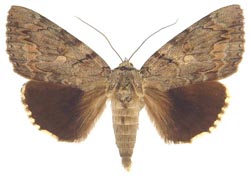
| Catocala agrippina; 75-85mm; In the male, the fws are grey-black with some reddish brown (distinguishing characteristic); am and pm lines are black, darker toward costa, much lighter near inner margin. Reniform is indistinct and brown; sub-reniform is almost obsolete, but lighter than surrounding areas. Hws are black, with greyish hairs at base and im. Fringe is white, only partly cut with black at terminations of veins. |
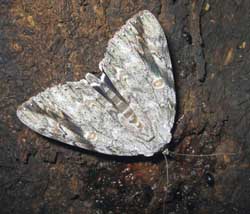
| ** 8793 Catocala maestosa. Sad Underwing, 78-98mm: Maesotsa is quite similar to, although usually larger than, vidua. Both have the dark arc from the costa, above the reniform spot, to the outer margin just below the apex. Maesotsa, however, lacks the dark bar, found on vidua, parallel to the inner margin. The reniform spot is brown and there is brown shading just outside the postmedial line. The hindwing fringe is white, narrow and heavily barred. |
Large Black Underwings (Banded): Wingspans: 70-80mm
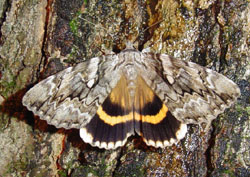
| ** 8802 Catocala cerogama; Yellow-Banded; 70-80mm. Several different forms. Pm line distinct, dark and has elongate pair of projections. Pm and am lines meet inner margin in relative proximity. Closed subreniform spot lighter than surrounding areas, shaped a bit like an arrowhead with point toward body. Hws are distinctive. Jean-Benoît Duval image. |
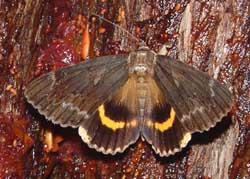
| ** 8802 Catocala cerogama; Yellow-Banded; 70-80mm.Form ruperti: Forewings are almost uniform grey-brown with white scales outlining subterminal line. The hindwings are distinctive. Tim Dyson image. |
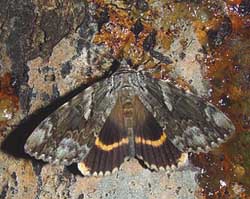
| ** 8802 Catocala cerogama; Yellow-Banded; 70-80mm.Form bunkeri: Forewings are dark in median and basal areas. Hw golden band is reduced in thickness. Basal hairs are brown instead of yellow. The hindwings are distinctive. Tim Dyson image. |
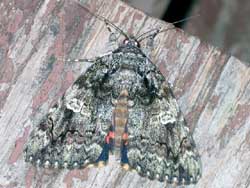
| ** 8801 Catocala ilia; Ilia; wingspan: 65-82mm. Several different forms, most have characteristic white area in and around reniform spot. Diffuse dark arc running from this spot to just below apex. Subreniform spot squarish, concave inner and outer edges and elongated constriction connecting it to pml. White dots near fw om in character with the overall "contrasting" appearance. |
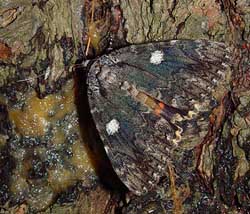
| ** 8801 Catocala ilia; Ilia; form conspicuaIn this form the entire reniform spot is heavily suffused with white scaling on an otherwise darker ground colour. Hence the form name "conspicua". Tim Dyson image. |
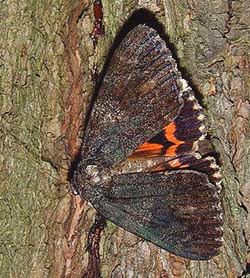
| ** 8801 Catocala ilia; Ilia; form satanasIn this melanic form the entire forewing, including the reniform spot is very dark. Hence the form name "satanas". The dark basal streak is still evident on this form. Tim Dyson image. |
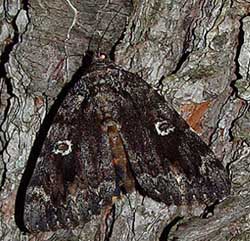
| ** 8801 Catocala ilia; Ilia; form normaniIn this semi-melanic form the entire forewing, excluding the reniform spot, is relatively dark. The brownish, kidney-shaped center of the reniform spot is outlined in white. The basal streak and subapical arc are still visible. Tim Dyson image. |
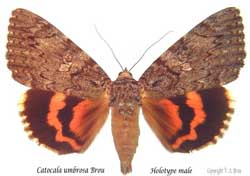
| ** 8857.1 Catocala umbrosa; mm; Double brown am line, inward line fainter, filled with off white; reniform spot brown center outlined in black , off white and black again; subreniform, large, pale brown, closed. Pm line wit htwo elongated upper teeth, next tooth reduced, next two progressively longer, rounded, final lobe rounded and shorter. HW with dark scaling/hairs in basal median area along im |
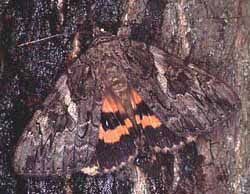
| ** 8771 Catocala piatrix ; Penitent, wingspan: 68-84mm. Fw: light-colored band/bar extending from light coloured, triangular subreniform spot along am line to costa. Brown, kidney-shaped reniform spot surrounded in pale grey, outlined in black, usually with distinct black along wing veins in a dark area outside the reniform spot. Hw: fringe lightly barred; lighter in color than deeper orange on rest of wing. |
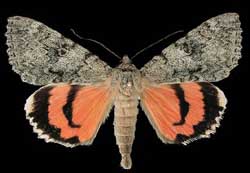
| Catocala junctura; Joined Underwing; 67-85mm; Fw usually dark brownish-gray to evenly powdered blue-grey w/o significant markings. Doubled reniform spot often obscure. Thin, slightly darker am/pm lines from costa to im, not widely spaced at im. Hw salmon or orange-pink with narrow inner black band that turns in sharply, does not meet dark-haired im, distinguishing it from unijuga. |
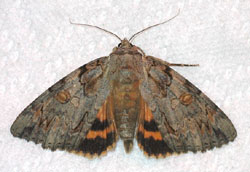
| ** 8798 Catocala neogama; wingspan 70-85mm. Brown head, thorax, larger size as compared to C. palaeogama. Neogama tend to be slightly smaller than subnata, have darker grey brown fws with more pronounced markings. Examination of hind tibia needed for id. Neogama's: flattened, unevenly, sparsely spined; subnata's: cylindrical, spines dense, uniform in distribution. Joe Garris photo. |
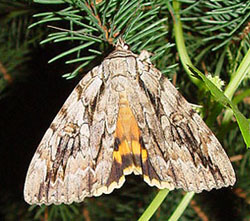
| ** 8797 Catocala subnata; Youthful Underwing: 75-90mm. Fws greyish white with blue-grey and light brown scales, usually with hws brighter yellow than those of neogama. Neogama usually have basal dash; absent in male subnata, but present in females. Magnification of hind tibia needed for id: subnata: cylindrical hind tibia; neogama: compressed or flattened hind tibia. subnata: ventral surface of tibia densely covered with evenly distributed spines; neogama: ventral surface of tibia sparsely covered. |
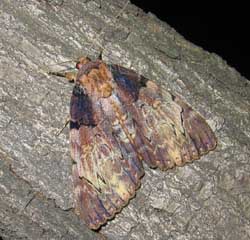
| Catocala nebulosa; Moths have prominent dark brown upper-half-basal patch that extends to and ends at antemedial line. Apical area also tends to be brown, much darker than median area but not as dark as basal patch. The anal angle also has the darker brown scaling. The pm line is distinct near costa and inner margin, but becomes weak between the two. It meets inner margin in relative close proximity to am line. Closed subreniform spot is large and connects to the pm line via a thin line. |
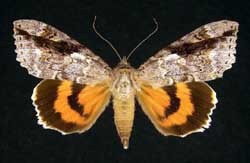
|
** 8804 C. marmorata;
Marbled; wingspan 85-95mm |
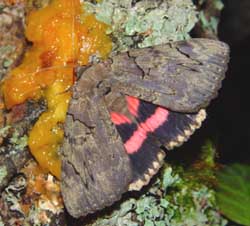
| ** 8832 Catocala cara; Darling; wingspan 70-85mm: Note deep maroon almost purple cast to forewings, mixed with very pale green. Lower half of am and pm lines is barely visible. No distinctive bars or dashes. Two upper "teeth" on pm line are thin and long. Hw bands are pink. Heavy black checking on the off-white hindwing fringe. The relatively thick black median band of the hindwing almost reaches the inner margin which is usually heavily adorned with dark hairs. Tim Dyson image. |
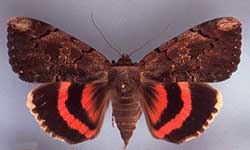
| ** Catocala carissima; wingspan 70-85mm. Distinct light grey brown area at fw apex, preceded just inside pm line by slightly darker patch. Am and pm lines sharp and dark. Hw inner black band wide, complete, merges with extensive grey-black scaling along im. Hw fringe cream coloured. |
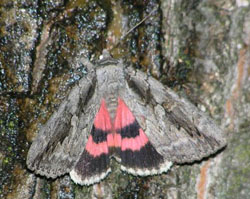
| ** 8834 amatrix Sweetheart Underwing; (wingspan 75-95mm). Very skittish, frequently hides in caves, under bridges, under tree bark, etc. by day, resting with head down. Hw patterning and colouration similar to that of C. concumbens, but large size (wingspan 75-95mm) and dark bar running from basal area to just below apex distinguishes C. amatrix. See large Catocala amatrix courtesy of Joan F. Rickert. |
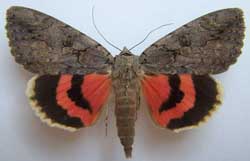
| ** 8834 amatrix form selecta
Sweetheart Underwing; (wingspan 75-95mm) |
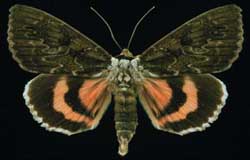
| ** 8834 amatrix form hesseli
Sweetheart Underwing; (wingspan 75-95mm) |
The USGS confirms the following species for Arkansas:
Girlfriend Underwing (Catocala amica)
Scarlet Underwing (Catocala coccinata)
Epione Underwing (Catocala epione)
Ilia Underwing (Catocala ilia)
Magdalen Underwing (Catocala illecta)
Girlfriend Underwing (Catocala lineella)
The Widow (Catocala vidua)
Catocala orba probably flies in southern Arkansas based on reports by Heppner, Covell, Brou.
Catocala umbrosa is confirmed for Arkansas by Vernon Brou.
Heppner indicates texarcana and lincolnana fly in Arkansas
Subsequent to developing this list I was able to find a survey (Robert T. Allen and Richard L. Brown) for Magazine Mountain, Logan County, Arkansas, listing amica, andromedae, cerogama, coccinata, crataegi, dejecta, epione, gracilis, ilia, lacrymosa, micronympha, palaeogama, residua, reteecta, ulalume at http://74.125.47.132/search?q=cache:rMjmCPzZ9c8J:libinfo.uark.edu/aas/issues/1991v45/v45a5.pdf+Catocala+of+Arkansas&hl=en&ct=clnk&cd=17&gl=ca
and a Columbus Prairie, Hempstead County, list for
Catocala amatrix, Catocala amica, Catocala cara, Catocala connubialis, Catocala epione, Catocala ilia, Catocala illecta, Catocala innubens, Catocala lineela, Catocala micronympha, Catocala mira, Catocala retecta, Catocala vidua
Catocala atocala is probably also present in swampy areas as per http://research.yale.edu/peabody/jls/htms/2000s/2002-56(1)1-Gall.htm.
Catocala lincolnana is a species of special concern in Arkansas as per http://www.naturalheritage.org/pdf/ANIMALS-Inverts-2005.pdf Arkansas National heritage Commission.
Use your browser "Back" button to return to the previous page.
Return to Canadian Index
Return to Main Catocala Index
Enjoy some of nature's wonderments, giant silk moth cocoons. These cocoons are for sale winter and fall. Beautiful Saturniidae moths will emerge the following spring and summer. Read Actias luna rearing article. Additional online help available.
Eggs of many North American Saturniidae species are offered during the spring and summer. Occasionally summer Actias luna and summer Antheraea polyphemus cocoons are available. Shipping to US destinations is done from within the US.
This page is brought to you by Bill Oehlke and the WLSS. Pages are on space rented from Bizland. If you would like to become a "Patron of the Catocala Site", contact Bill.
Please send sightings/images to Bill. I will do my best to respond to requests for identification help.

|
butterfly to the left, a link to many worldwide insect sites. |